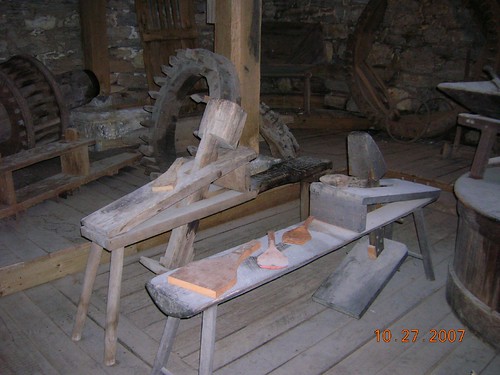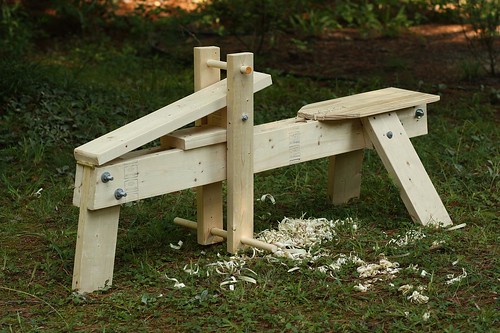Until my first day doing living history I’d never used a shaving horse before, never used a drawknife or a spokeshave. I’d always thought that someday I might like to take a chairmaking class, just for fun, but that it wasn’t something I really saw myself doing much.
Shows what I know. One day muddling my borrowed-tool way through demonstrations and I knew I needed a shaving horse and tools of my own, if only so that I could pay decent respect to the real craftsmen whose role I was playing. It turned out, though, that even though a shaving horse is one of the simplest, rough-and-tumblest workbenches a man can make, it might just be harder to make in 2011 than it would have been in 1700. I had to get a little inventive. What follows is the story of my thirty-dollar, down and dirty, twenty-first century shaving horse.
A shaving horse is a sort of seated workbench: you sit on the bench, straddling it like a horse, while holding your work fast to an angled table with a clamp operated by a foot treadle. It’s easier to show than to explain, so see the photos:
In Ye Olden TimesTM, a craftsman built his own shaving horse from a six-foot hunk of sturdy tree, hewing it into existence with axe and froe. The log was one he’d likely cut himself from a nearby woods, perhaps his own woodlot. Built to the owner’s dimensions, the result was rough, cheap, practical, and comfortable.
Cheap, practical, and comfortable were exactly what I was looking for, and I was fine with rough. But cheap and practical have changed a bit in a century or two. Walking into the woods with an axe wasn’t going to be practical for me, and getting a decent, dry six-foot log wasn’t going to be cheap, at least not factoring in the time it would take to procure it. My own woods is small and immature; the half-dozen big trees are too valuable to think of cutting down. Not to mention that my woodworking skills didn’t develop, as Roy Underhill used to say, by starting with a tree and an axe and making one thing after another until I had a house and everything in it. I started by making furniture with modern hand tools and have only gradually worked my way back through finish carpentry and chicken-coop construction to simpler means of working. I’m not much good with an axe once the tree is horizontal.
What, then, does the practical craftsman in 2011 do?
Why, he goes to the lumberyard, of course! His local independent lumberyard, if he still has one, but any big-box retailer — the “Home Bastard,” as my brother-in-law would say — will do. He uses dimensioned whitewood off the rack and hardware off the shelf.
But how to build the thing? The only horses I’d seen in person or owned books about building were the log-and-axe models. Searching for construction ideas, I mostly ran into dead ends. There are plans, of course, but I can’t see building a shaving horse from plans. Using somebody else’s plans is just following directions, and if I’m just following directions I might as well be at work in an office, or back in school. Boughten plans suggest a lack of savoir faire and joie de vivre and other French-ish sorts of things that trip lightly but impressively off the tongue after a couple of martinis. Moreover, to tack rather differently, they are not especially manly. Pa Ingalls did not order plans for the Little House on the Prairie on the internet.
Photographs would be plenty, with if possible a few jotted notes on construction, but I didn’t find anything that suited my needs. Shaving horses, at least those whose owners proudly display them on the internet, seem to fall largely into one of two camps. There are the rustic-charm horses built with an axe and a tree, and there are the showpieces crafted lovingly from beech with sculpted seats and elegant curves. We’ve already established that I’m not charmed by rusticity, and I wasn’t interested in a showpiece — those are somebody’s second or third or fourth shaving horse, what they build to use in public at craft fairs and festivals after they’ve experimented awhile on a simpler model. I wanted to make something I could screw up without wasting a lot of money. I could always make another one later, after I’d figured out what I really needed.
After sifting through dozens of photos I finally found something that looked like it had been hacked together from scraps salvaged from a dumpster (scaling the eight-foot fence, a beach towel over the barbed wire, fighting off the doberman with a bravely brandished spokeshave and a snarl). Exactly what I was looking for, in other words. It was a grainy little photograph, but enough to give me the idea.
The actual construction involved a lot of trial and estimation. How high should the bench be? I sat on an old chair with my legs poised as they would be at the horse and decided that it was just about the right height, a little higher than the horse I’d used before. The table, the part the work rests on, ought to point at about your navel, and I played around with lengths and angles until I found something that felt right. The distance between seat and treadle has to be comfortable, too, and that affects the position of the table, because the end of the table shouldn’t be too near to or far from the seat. And so on. That’s a more practical reason why you may not want to make a shaving horse from plans: it may not fit you. Remember you’re going to be spending a lot of time sitting at the horse, and the nearer and more comfortably it’s an extension of your own body, the better and easier will be the work.
My shaving horse is what’s called the “English” style. On a traditional tree-and-axe shaving horse, the wood is held in place with a dumbhead, a big, broad, solid clamp, and the shaft comes up through a hole in the solid benchtop. That’s known as the “European” style, although English craftsmen used that too until about 1800. The newer sort of horse clamps with a sold bar that runs the width of the table, with two vertical braces that run along the outside of the bench. Again, this is easier to see in the photos. Here’s a traditional model:
And here’s mine again:
I chose the English style because I thought I’d prefer the clamping mechanism (and I do), but also because the older style requires a solid top, and I didn’t have stock thick enough (at least 8/4) for a good solid top, nor did I want to buy 8/4 lumber. A plywood seat on joists is plenty sturdy.
A few construction notes:
- The horizontal beams are two 2×6 boards, spaced by the front leg and a short piece of 2×6 at the back and held together by ½-inch carriage bolts.
- The legs are also 2×6. I’m not sure what the angle of their splay is; I just eyed it up and then fixed it with my bevel gauge. Enough to hold the thing up without taking up too much extra space, I suppose. Note that the back legs have to be cut at a compound angle; they splay back as well as out. Between each back leg and its side beam is a spacer, cut to the same angle as the splay of the leg, and the back legs are held on by ½-inch carriage bolts (10-inchers, if I recall correctly) as well as a couple of deck screws.
- Most of the carriage bolts were a little or a lot longer than I needed; I took this project as an opportunity to use up some spare hardware. I sawed off the extra with a hacksaw so they wouldn’t stick out too far and catch on anything.
- The table is held to the front of the beams by a door hinge I had lying around the shop. You could fix it with nails or screws, but I found the hinge a help in adjusting the angle. The other end of the table rests on a piece of 2×4 mortised into a piece of 2×6; this will be clearer from the photo.
- The treadle and clamp mechanism is the tricky part. I used 1-inch dowels for both clamp and treadle — the last thick dowels I should ever have to buy, I hope, now that I’ve got a shaving horse! They’re connected by 2×4s, and the mechanism pivots on another carriage bolt, spaced out by extra washers. Here I wish I’d had a drill press: the hole for the pivot bolt goes through the long grain of the 2×4 in the table prop, and I didn’t get it perfectly straight with my brace and bit. It’s close enough, though, and the slight skew of the clamp hasn’t caused any problems.
- The seat is plywood, attached to the beams with deck screws. This was the last piece to go on, and I measured the width and length by what felt comfortable to me. I cut off the front corners, then decided that the sides needed to slope back more gradually for comfort. Again: leave room to adjust as you go.
The horse is seriously comfortable — I spent almost four hours at it on Saturday and it felt great — and the clamp action works far better, honestly, than I expected it to. The final cost was about twenty-seven dollars in lumber and hardware, plus some scrap and leftovers I already had. Not bad, and I had enough cash left over to buy a few sample-sized containers of paint. I think it needs flames on the side.

